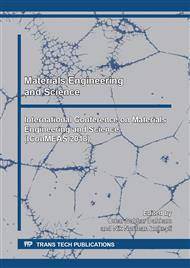[1]
D. S. AHLAWAT, STUDY OF BAND GAP ENERGY AND THERMAL PROPERTIES OF PbI 2 BY PHOTOACOUSTIC SPECTROSCOPY ,, Mod. Phys. Lett. B, vol. 26, no. 16, p.1250098, (2012).
DOI: 10.1142/s0217984912500984
Google Scholar
[2]
A. M. Jafar, M. H. Suhyl, and F. I. Mustafa, Organolead Iodide Perovskite Solar,, vol. 2, no. 6, p.81–87, (2016).
Google Scholar
[3]
Aqel Mashot Jafar, Mahdi Hasan Suhail, Falah Mustafa Al-Attar, & M. K. K. ORGANOLEAD HALIDE PEROVSKITE SOLAR CELLS,, in 32st European Photovoltaic Solar Energy Conference and Exhibition, p.1296–1302, (2016).
Google Scholar
[4]
Z. Shi and A. H. Jayatissa, Perovskites-based solar cells: A review of recent progress, materials and processing methods,, Materials, vol. 11, no. 5. (2018).
DOI: 10.3390/ma11050729
Google Scholar
[5]
M. H. Suhail and A. M. Jafar, Fabrication and Characterization of Organolead Halide Peroviske Solar,, vol. 98, p.42709–42713, (2016).
Google Scholar
[6]
W. Wang et al., Highly Sensitive Low-Bandgap Perovskite Photodetectors with Response from Ultraviolet to the Near-Infrared Region,, Adv. Funct. Mater., vol. 27, no. 42, (2017).
DOI: 10.1002/adfm.201703953
Google Scholar
[7]
I. B. Oliveira, F. E. Costa, M. J. Armelin, L. P. Cardoso, and M. M. Hamada, Purification and Growth of PbI 2 Crystals : Dependence of the Radiation Response on the PbI 2 Crystal Purity,, no. September, (2002).
DOI: 10.1109/nssmic.2001.1009289
Google Scholar
[8]
B. Cohen, S. Gamliel, and L. Etgar, Parameters influencing the deposition of methylammonium lead halide iodide in hole conductor free perovskite-based solar cells Parameters influencing the deposition of methylammonium lead halide iodide in hole conductor free perovskite-based solar cells,, vol. 81502, (2014).
DOI: 10.1063/1.4885548
Google Scholar
[9]
A. M. Jafar, K. Al-amara, F. L. Rashid, and I. K. Fayyadh, NanoTechnology Fabrication and Characterization of Fluorine-Doped Tin Oxide Transparent Conductive Nano-Films,, p.20107–20111, (2013).
Google Scholar
[10]
A. M. Jafar, K. Al-amara, T. M. Lafta, M. H. Mahmod, and I. M. Abood, Fabrication and Characterization of P-Type Co-Doped Tin Oxide Nano-Films,, vol. 65, p.19799–19803, (2013).
Google Scholar
[11]
D. Shen et al., Understanding the solvent-assisted crystallization mechanism inherent in e ffi cient organic – inorganic halide perovskite solar cells †,, J. Mater. Chem. A Mater. energy Sustain., vol. 2, p.20454–20461, (2014).
DOI: 10.1039/c4ta05635c
Google Scholar
[12]
A. F. Silva and I. Pepe, Electronic and optical properties of lead iodide,, vol. 92, no. 12, (2002).
Google Scholar


